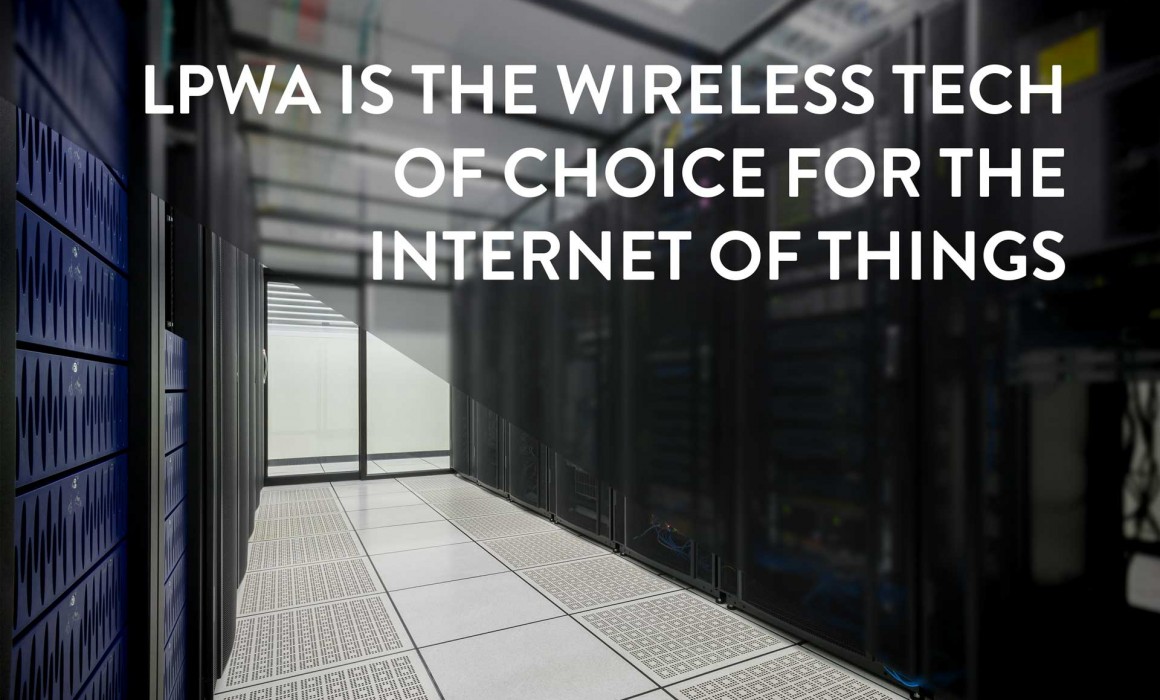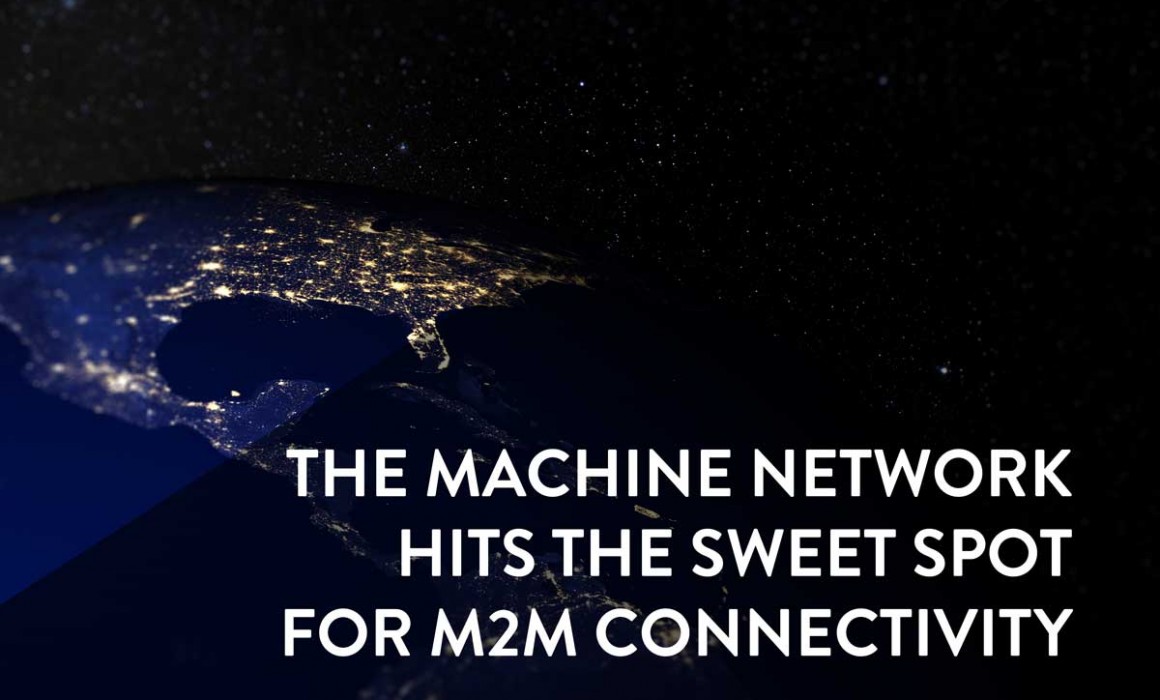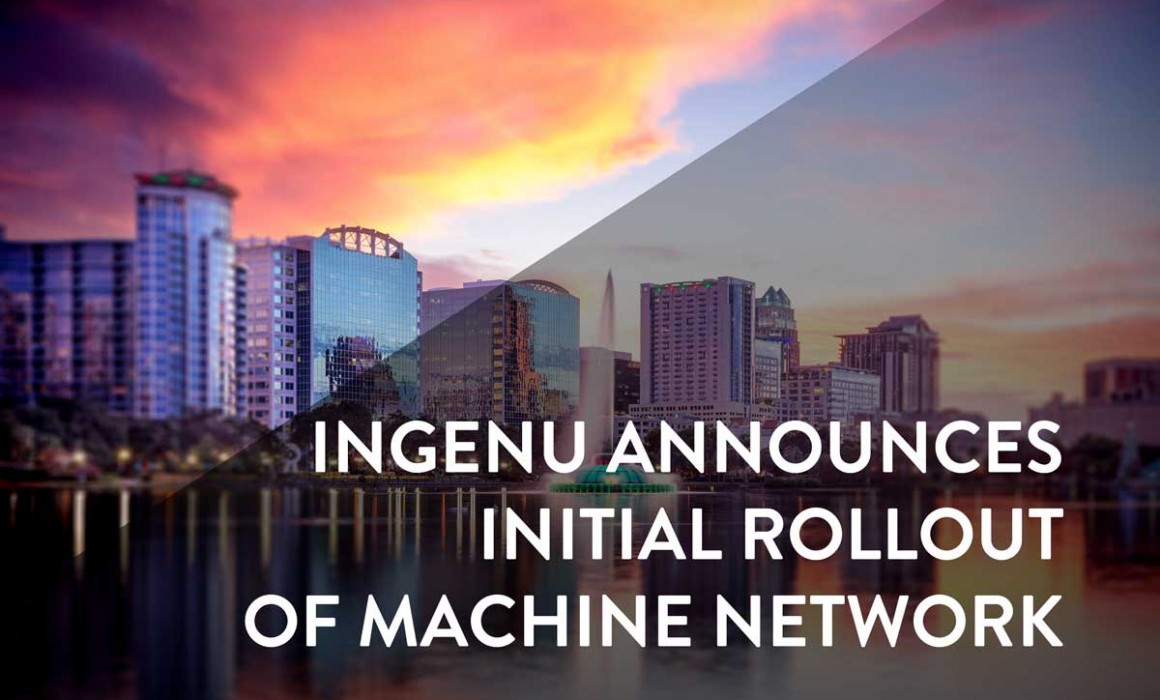Ingenu and WellAware Announce Machine Network Expansion
LAS VEGAS, NV–(Marketwired – Jan 6, 2016) – Consumer Electronics Show — Ingenu, the pioneer in delivering connectivity exclusively to machines, and WellAware, the oil and gas industry’s only full-stack solution for oilfield production monitoring and optimization, announced the collaborative expansion of the Machine Network™ that will provide approximately 55,000 square miles of coverage to the network’s rapidly growing nationwide footprint. Covering the greater Texas geographic area, the public network, powered by Ingenu’s RPMA® (Random Phase Multiple Access) communications technology, will provide unparalleled coverage in the region, serving a variety of industries, including WellAware’s significant offering of oil and gas applications.
The expanded network will provide coverage for the most active U.S. oil and gas fields, representing more than 50 percent of total U.S. production. Additionally, with the scalable architecture of Ingenu’s RPMA technology, myriad IoT and M2M devices can be added without the need for further network investment, spurring new application opportunities in the coverage area.
“The solid partnership with WellAware has enabled Ingenu to accelerate its Machine Network build-out strategy in the Southern U.S.,” said Ingenu CEO, John Horn. “WellAware has developed extremely innovative, secure and reliable solutions based on our RPMA technology, and we will continue to collaborate and extend the Machine Network as they expand application services in the oil and gas market.”
For its oil and gas customers, WellAware will continue its focus on the development of production data services, which are designed help exploration/production and pipeline companies capture and use their data to the best advantage for peak operating efficiency. WellAware helps oil and gas operators achieve these synergies through reliable data collection, exception-based monitoring, and actionable insights.
“The expansion of the Machine Network will provide our customers and prospects with seamless network coverage and management options for monitoring and data collection of their oilfield assets, even in the most remote areas of the oilfield,” said Matt Harrison, president and CEO, WellAware. “The RPMA technology has been proven in the most challenging of network environments, and we are looking forward to bringing new applications to market which will enable our customers to dramatically to reduce operating expenses and enhance oilfield intelligence.”
The Ingenu/WellAware Machine Network build-out is currently in progress and will continue expansion of additional oil and gas fields throughout 2016. To find out when the Machine Network will be coming to your area, please visit http://www.ingenu.com/coverage-lookup/.
About Ingenu
Ingenu is building the first wireless Machine Network, the world’s largest IoT network dedicated to connectivity for machines. Operating on universal spectrum, the company’s RPMA® technology is a proven standard for connecting Internet of Things (IoT) and machine-to-machine (M2M) devices around the world, with more than 35 networks deployed over seven years. The Machine Network™ will have further reach, global range and longer lasting battery life than any existing network. It is also future-proof — enabling technology solution providers to maximize their product’s efficiency and longevity, with unparalleled control and visibility. Ingenu is led by a highly experienced team and backed by one of the strongest boards in the industry, including veterans from Verizon and Qualcomm. Information about Ingenu can be found at www.ingenu.com, or follow us on Twitter @ingenunetworks.
About WellAware
WellAware, a data analytics company for the oilfield, enables upstream, midstream, and chemical service companies to reduce operating expenses, minimize downtime and ensure safety and regulatory compliance. Our full-stack solution provides reliable data collection, exception-based monitoring, and actionable analytics. Based in San Antonio, Texas, the company has secured $61 million in investment funding and built a world-class team of management and advisors from the oil industry. To learn more about WellAware, please visit www.wellaware.us.
Media Contacts:
Justine Schneider
Calysto Communications
Email: jschneider@calysto.com
Phone: +1-201-921-9428
Kirsten Garvin
Ingenu
Email: kirsten.garvin@ingenu.com
Phone: +1-760-533-6945
Dave Milam
WellAware
Email: davemilam@wellaware.us
Phone: +1-512-361-1270
How to Make Sense of Your IoT Connectivity Options
Anyone considering an M2M investment has many options. From local area solutions like a WiFi mesh network, or LPWA, to wide area solutions such as cellular or Ingenu’s own RPMA, the options can be baffling at first glance. There are a few questions you can ask yourself, and ask of each of the potential solutions to help simplify the decision process and get to the choice that makes sense for your situation.
First, you need to consider just how long you would like the solution to last you with little to no need to physically interact with the devices. Some solutions are driven by human data usage needs, like cellular. In the cellular case, you can expect network sunsetting every 5 to 10 years as newer generations of technologies are developed, like the upcoming 5G. Another issue to consider for how long the solution can last is scalability.
If your company has plans to grow, or could conceivably grow in the coming years, you should make sure that the connectivity solution can grow with you. A sneaky part of this question that you should understand is knowing whether your connectivity solution can grow with everyone using it. This is something called capacity scalability, and many IoT wireless solutions have the fundamental inability to scale as more companies use their services. Another aspect of scalability is simply the cost of coverage scalability. Many IoT wireless providers have extremely limited coverage per access point. That means putting up the infrastructure could be too costly to cover the areas you need served. Don’t limit your growth because your IoT wireless service provider can’t grow with you. There are other issues such as battery life that could limit the longevity of your devices’ usefulness.
Other criteria for simplifying your options include assessing what capabilities each provider offers. A top capability should be security along with true two-way communication. Finally, total cost of ownership should be used to help you understand the value you are receiving from your M2M investment. IoT connectivity is more than the device, and includes any sunsetting costs, maintenance, subscription costs, and others.
We’ve developed a great webinar that we invite you to attend to help you make sense of your IoT connectivity options. Go here to watch the webinar, grab the slides, and download the Q&As from the webinar.
Ingenu Announces Initial Rollout of Machine Network
First national network dedicated to the Internet of Things to launch in major cities across the United States
 SAN DIEGO – Nov. 10, 2015 — Ingenu, the pioneer in delivering connectivity exclusively to machines, today announced the initial rollout of its Machine Network™, covering 30 major metropolitan areas across the United States by the end of 2016. Once the first phase is operational, the Machine Network will be the nation’s largest exclusive Internet of Things (IoT) and machine-to-machine (M2M) network, serving approximately more than 100 million users across the United States, and covering an area of nearly 100,000 square miles.
SAN DIEGO – Nov. 10, 2015 — Ingenu, the pioneer in delivering connectivity exclusively to machines, today announced the initial rollout of its Machine Network™, covering 30 major metropolitan areas across the United States by the end of 2016. Once the first phase is operational, the Machine Network will be the nation’s largest exclusive Internet of Things (IoT) and machine-to-machine (M2M) network, serving approximately more than 100 million users across the United States, and covering an area of nearly 100,000 square miles.
Link Budget, More Than How Much You Spend on Sausage

Link budget is one of those magical terms that to most people means pretty much nothing, but if understood, quickly tells us so much.
Link budget isn’t how much you pay for online ads and it isn’t the budget you have per bratwurst link either. As you may have guessed, link budget is an engineering term. Link budget is actually the single most revealing metric for any wireless technology. It measures the signal power available for transmitting messages and is measured in dB (decibels). The higher the link budget the better signals propagate, or fly through the air with reckless abandon.
Link budget can be spent on a combination of coverage area, reliability of coverage, or penetration depth. If you were to take two wireless technologies and know nothing about them except their link budget you would easily know which one can provide more coverage, coverage reliability, and coverage penetration. And all three of those things are great for your M2M and IoT connected devices.

RPMA’s link budget, at 172 dB (FCC) in actual commercial deployments, is the highest among all IoT wireless options (Cellular: 164-167 dB; LPWA: 149-157 dB). RPMA also has the leading link budget in Europe with 168 dB (Cellular: 155-158 dB; LPWA: ~161 dB). Some may wonder why there is a difference between the FCC and Europe, and it’s not because Europe has syrupy air getting in the way of wireless signals. It all comes down to government regulations (darn those politicians!). Different radio frequency bands have different regulations governing how much power can be used to send and receive signals, among other things. The less power you are allowed to use means the less link budget you’ll get.
Link budget is magical in another way: a unit increase in link budget (say 1 dB) leads to an exponential increase in coverage. So to have one more dB than cellular means we get many multiples increase in coverage, not just a single unit increase in coverage. Link budget is the end result of combining receiver sensitivity, transmission power, antenna gain, legal restrictions in various regions, the natural propagation of the band chosen and ways to enhance each. RPMA’s link budget gets its largest boost from its industry leading receiver sensitivity at -142 dBm. Receiver sensitivity indicates how weak an incoming signal can be and still be obtained by the receiver. It’s like RPMA has super sensitive ears that are able to hear even a panting snail trying to cross a busy sidewalk.
For a quick and revealing way to compare wireless technologies look at link budget as it exists in actual real world commercial deployments (because it’s easy to say you have a much higher link budget before you actually deploy in real world conditions). So, that’s your primer on link budget, spend it well.
To learn how RPMA has such incredible link budget, download our white paper, How RPMA Works, or contact us at info@ingenu.com.
IoT Battery Life
It may not be the lead-off topic you’re looking for as you make that big impression on your next date, but what IoT battery life lacks in flash, it makes up for in utility and consequence. Device power consumption warrants tremendous consideration when designing and deploying IoT/M2M solutions. This is most salient to consumers when they need to make an important phone call, only to have their battery die in mid-sentence. This exact scenario could happen to devices where battery life wasn’t properly considered or understood.
 For many years it has been more than acceptable to live within the limitations of consumer-grade battery life that offers comparable longevity to last night’s dinner. We are trained to fit the routine of plugging a cell phone into the wall on a daily basis. Likewise, we’ve been trained to think that as we develop M2M and IoT solutions that we must live within the same boundaries that restrict us as humans (i.e. cell phones, tablets, laptops). Those boundaries include depth and range of coverage, cost, and, of course, power consumption. The truth is that the wireless technologies that enrich our lives on one hand as humans are being used on the other hand as a retrofit to support a immense convoy of several billion machines that require an entirely different set of priorities and characteristics. Here are just a few considerations:
For many years it has been more than acceptable to live within the limitations of consumer-grade battery life that offers comparable longevity to last night’s dinner. We are trained to fit the routine of plugging a cell phone into the wall on a daily basis. Likewise, we’ve been trained to think that as we develop M2M and IoT solutions that we must live within the same boundaries that restrict us as humans (i.e. cell phones, tablets, laptops). Those boundaries include depth and range of coverage, cost, and, of course, power consumption. The truth is that the wireless technologies that enrich our lives on one hand as humans are being used on the other hand as a retrofit to support a immense convoy of several billion machines that require an entirely different set of priorities and characteristics. Here are just a few considerations:
- Frequency: Think for a minute about how many times in a day that you check your phone – you may have already checked it once or twice since you began reading this post. We consume data in a way that is frequent, requires large data packets, and is expected to be instant. During the intervals of quiet (when no data is being transmitted) these devices can go into a sort of hibernation that allows for immense power savings.
- Packet size: The Internet of Things, by contrast, is made up of all kinds of devices, sensors and machines that in most cases are sending significantly smaller pieces of data with far less frequency. Machines don’t have to be cordial and listen to your Aunt Susan’s rant about the local politicians, or download all of the imagery that is sent along with your other messages – it cuts directly to the point, as succinctly as possible.
- Data transmission protocols: These can vary greatly from human/consumer-based protocols. From UDP to TCP to a RESTful-based approach, machine communication protocols can greatly impact the power requirements of a device.
This is really just the beginning of the variables that impact the design and deployment of IoT solutions, related to power consumption. As such, devices with a minimum of 10-year battery life will quickly become the standard for Machine-to-Machine (M2M) communications. Download our white paper on battery life to find out what other secrets you can unlock to harness the battery power of IoT devices.
Ingenu and Meterlinq Announce Public Internet of Things Network Deployment in Italy
Nationwide Network—Built Specifically for M2M and IoT Traffic—to Serve Applications Across the Country
CTIA Super Mobility, LAS VEGAS – September 10, 2015 — Ingenu, the pioneer in delivering connectivity exclusively to machines, and Meterlinq srl, a provider of secure telemetry and remote-management infrastructure for smart metering and smart grid services, today announced the deployment of a public, nationwide network in Italy specifically designed to provide connectivity for machine-to-machine (M2M) and Internet of Things (IoT) applications. The network will provide monitoring services for utilities and other applications throughout the country.
Ingenu Announces Launch of the Machine Network
The Industry’s First Nationwide Network is Purpose-Built Exclusively for M2M / IoT Connectivity
CTIA Super Mobility, LAS VEGAS – September 9, 2015 — Ingenu, the pioneer in delivering connectivity exclusively to machines, today announced the launch of the Machine Network™, the first nationwide wireless public network dedicated entirely to machine-to-machine (M2M) and Internet of Things (IoT) connectivity. Based on Ingenu’s innovative RPMA® (Random Phase Multiple Access) technology, which has been successfully deployed in private networks around the globe, the Machine Network will make RPMA capabilities available at the public level. Anyone that utilizes M2M/IoT applications—from smart cities to smart agriculture—now has access to reliable, cost-effective connectivity.
2.4 GHz – The Ideal Unlicensed Spectrum for Long-Range IoT Networking (Part II)
2.4 GHz vs. 900 MHz – range, flexibility and the global marketplace
Range – Propagation and Other Key Factors
For building long-range IoT (Internet of Things) networks, the cost of connectivity is heavily driven by the coverage that can be achieved by each base station deployed in the network. Conventional wisdom says that long-range applications should use 900 MHz due to better propagation. Simply put, a technology with identical technical characteristics (receiver sensitivity, power output, etc.) will cover a wider area implemented in 900 MHz than in 2.4 GHz. Expressed in link budget, this advantage translates into a roughly 9 dB advantage for a 900 MHz system.
What is Link Budget? Link budget, along with assumptions on path loss, is sufficient to give the area covered for a given probability of coverage and a given indoor/underground penetration value. However, for real-world performance, the trade-off is not that simple. The 900 MHz and 2.4 GHz systems have other differences besides propagation loss that are important to performance of the overall system in providing coverage (See Table). Antenna diversity is a well-known technique for improving the effective link budget performance of wireless systems – two antennas with sufficient separation can be governed by independent fade margins. The separation required is directly related to the wavelength in question – providing a distinct advantage to 2.4 GHz systems. The much smaller separation required makes antenna diversity in IoT scale endpoints possible at 2.4 GHz – an option not even available to a technology implemented in 900 MHz spectrum. The improvement in effective link budget from antenna diversity in On-Ramp Wireless’ RPMA system is roughly 8 dB – almost completely offsetting the propagation advantage of a 900 MHz alternative.
What does this mean for the actual coverage of RPMA? Simply put, given the offsetting effects of these two differences, one can simply use link budget to compare the coverage performance of an RPMA system vs. any system implemented in 900 MHz.
2.4 GHZ vs. 900 MHz Comparison

(Stay tuned for the next week’s conclusion of this article)
Ted’s Corner
Recent Posts
Archives
Categories
april, 2025
No Events










